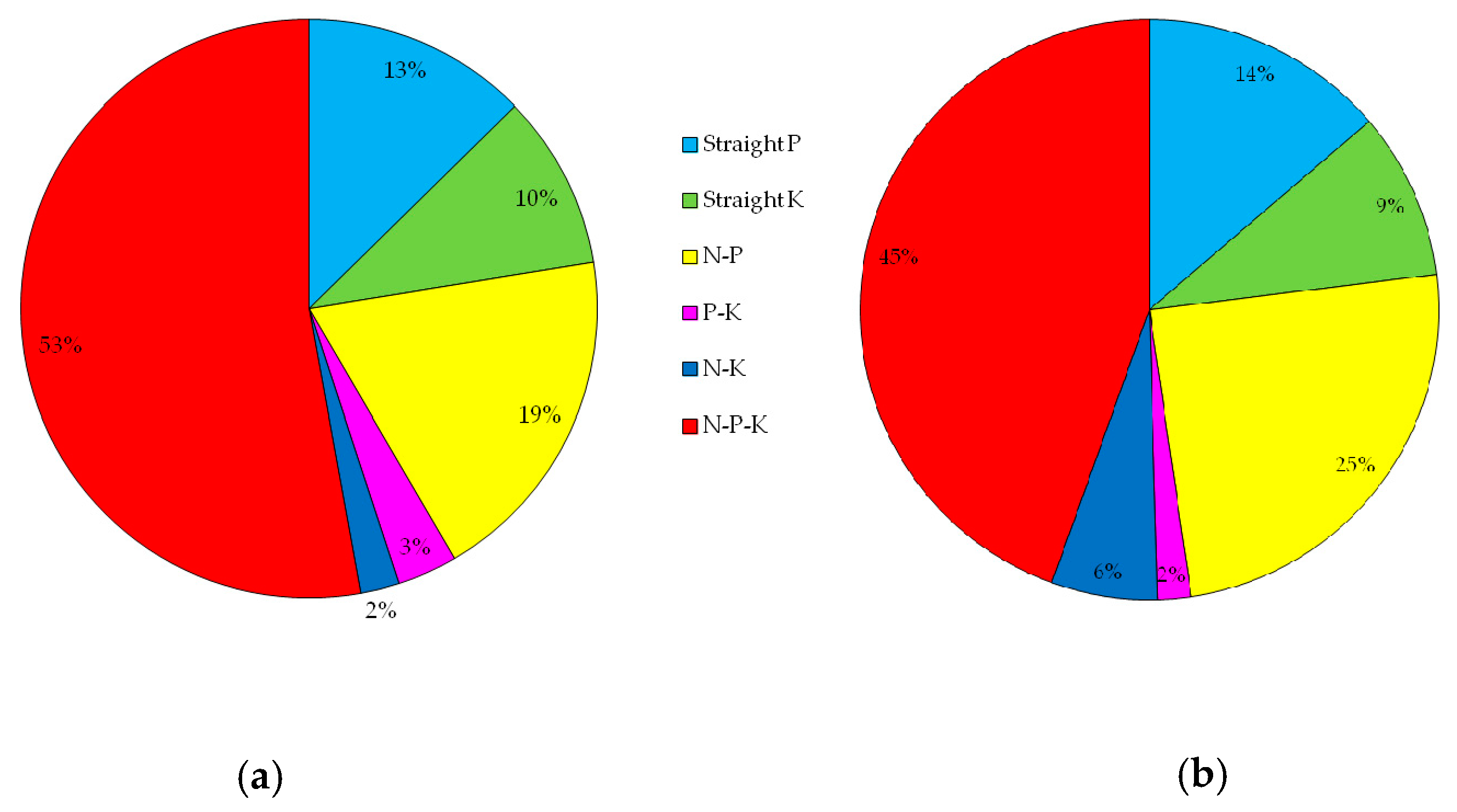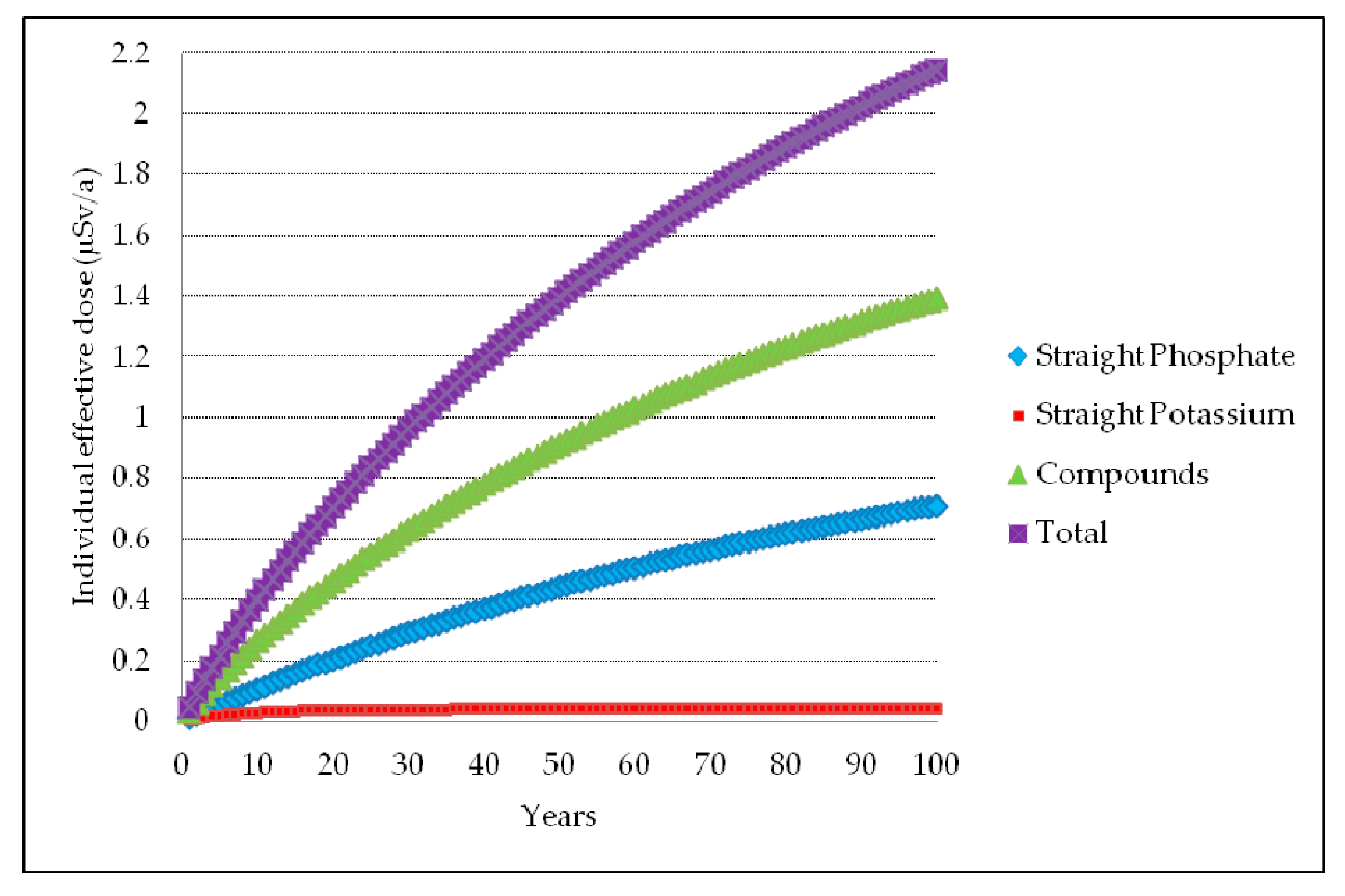Use of Fertilizers in Agriculture: Individual Effective Dose Estimate
Abstract
:1. Introduction
- phosphorites are minerals that contain radionuclide of 238U series in not negligible amounts; in the production of phosphoric acid through wet process, the radioactive equilibrium of phosphate rocks is disrupted during the chemical reaction, which leads to a redistribution of radionuclides. Previous studies have shown that radionuclides migrate according to their solubility in phosphoric acid or phosphogypsum. Accordingly, 226Ra is incorporated in the phosphogypsum, as its chemical behaviour is similar to calcium, 210Pb and 210Po also concentrate into phosphogypsum. The behaviour of Thorium depends on the chemical reaction and it is distributed in the two reaction products. The isotopes of Uranium form highly soluble compounds that are predominantly incorporated in phosphoric acid [2,3,4,5,6,7];
- MAP fertilizers contain 238U, but not 226Ra, as they derive directly from phosphoric acid;
- in SSP and TSP [5] both 238U and 226Ra are present;
- high activity concentrations of 40K are associated with the presence of potassium salts, with the 40K isotope in a standard ratio with respect to stable potassium; 40K makes up 0.012% of the total amount of potassium found in nature; and,
- in complex/mixed fertilizers the radionuclides content depends on the raw material used for phosphate and potassium components and on the production process.
2. Materials and Methods
2.1. Activity Concentration of Radionuclides in Italian Fertilizers
2.2. Activity Concentration of Radionuclides in Agricultural Soil
2.3. Calculating Model for Effective Individual Dose Evaluation for Use of Fertilizers in Agriculture
3. Results
3.1. Occasional Spreading of Fertilizers
3.2. Spreading of Fertilizers Over Time
4. Discussion
Author Contributions
Funding
Acknowledgments
Conflicts of Interest
References
- Legislative Decree 26 May 2000 n. 241. Attuazione della direttiva 96/29/EURATOM in materia di protezione sanitaria della popolazione e dei lavoratori contro i rischi derivanti dalle radiazioni ionizzanti. Gazz. Uff. 2000, 203, 140. [Google Scholar]
- International Atomic Energy Agency. Extent of Environmental Contamination by Naturally Occurring Radioactive Material (NORM) and Technological Options for Mitigation; Technical Reports Series Report N. 419; IAEA: Vienna, Austria, 2003. [Google Scholar]
- Mazzilli, B.; Palmiro, V.; Saueia, C.; Nisti, M.B. Radiochemical characterization of Brazilian phosphogypsum. J. Environ. Radioact. 2000, 49, 113–122. [Google Scholar] [CrossRef]
- Saueia, C.H.; Mazzilli, B.P.; Favaro, D.I.T. Natural radioactivity in phosphate rock, phosphogypsum and phosphate fertilizers in Brazil. J. Radioanal. Nucl. Chem. 2005, 264, 445–448. [Google Scholar]
- Saueia, C.H.R.; Mazzilli, B.P. Distribution of natural radionuclides in the production and use of phosphate fertilizers in Brazil. J. Environ. Radioact. 2006, 89, 229–239. [Google Scholar] [CrossRef] [PubMed]
- Santos, A.J.G.; Silva, P.S.C.; Mazzilli, B.P.; Favaro, D.I.T. Radiological characterisation of disposed phosphogypsum in Brazil: Evaluation of the occupational exposure and environmental impact. Radiat. Prot. Dosim. 2006, 121, 179–185. [Google Scholar] [CrossRef] [PubMed]
- Roselli, C.; Desideri, D.; Meli, M.A. Radiological characterization of phosphate fertilizers: Comparison between alpha and gamma spectrometry. Microchem. J. 2009, 91, 181–186. [Google Scholar] [CrossRef]
- Zampieri, C.; Trotti, F. Attività Lavorative Con Materiali ad Elevato Contenuto di Radioattività Naturale (NORM: Naturally Occurring Radioactive Materials); Anpa RTI CTN_AGF 3/2004; Agenzia Per la Protezione Dell’ambiente e Per i Servizi Tecnici: Roma, Italy, 2004; pp. 5–13.
- ISPRA (Istituto Superiore per la Protezione e la Ricerca Ambientale), ARPA/APPA. Censimento Attività/Siti Con NORM e Raccolta Delle Analisi di Rischio; Ispra Report Task 03.01.01; ISPRA (Istituto Superiore per la Protezione e la Ricerca Ambientale), ARPA/APPA: Roma, Italy, 2014.
- Council of the European Union. Directive 2010/75/EU of the European Parliament and of the Council of 24 November 2010 on industrial emissions (integrated pollution prevention and control). Off. J. Eur. Union 2010, L334, 17–119. [Google Scholar]
- Belli, M.; Blasi, M.; Jia, G.; Rosamilia, S.; Sansone, U.; Biancotto, R.; Bidoli, P.; Sepulcri, D.; Cavolo, F. Le Discariche di Fosfogessi Nella Laguna di Venezia: Valutazioni Preliminari Dell’impatto Radiologico; ANPA Stato Dell’ambiente 8/2000: Roma, Italy, 2000; ISBN 88-448-0285-6.
- RESRAD Version 7.2; Argonne National Laboratory: Argonne, IL, USA, 2016.
- Council of the European Union. Directive 2013/59/Euratom of 5 December 2013 laying down basic safety standards for protection against the dangers arising from exposure to ionising radiation, and repealing Directives 89/618/Euratom, 90/641/Euratom, 96/29/Euratom, 97/43/Euratom and 2003/122/Euratom. Off. J. Eur. Union 2014, L13, 1–73. [Google Scholar]
- Trotti, F.; Bucci, S.; Dalzocchio, B.; Zampieri, C.; Lanciai, M.; Innocenti, C.; Maggiolo, S.; Gaidolfi, L.; Belli, M. Towards the identification of work activities involving NORM in Italy. In Radioactive in the Environment; MacLaughlin, J.P., Simopoulos, S.E., Steinhäusler, F., Eds.; Elsevier: Oxford, UK, 2005; Volume 7, pp. 973–984. ISBN 0-08-044137-8. [Google Scholar]
- Bruzzi, L.; Canali, M.E.; Lucialli, P.; Righi, S. Misure di radioattività naturale e di radon in un impianto di produzione di fertilizzanti complessi. In Proceedings of the National Conference “Problemi e Tecniche di Misura Degli Agenti Fisici in Campo Ambientale”, Ivrea, Italy, 3–5 April 2001. [Google Scholar]
- Righi, S.; Lucialli, P.; Bruzzi, L. Health and environmental impacts of a fertilizer plant—Part 1: Assessment of radioactive pollution. J. Environ. Radioact. 2005, 82, 167–182. [Google Scholar] [CrossRef] [PubMed]
- Eurostat Statistics Explained. Available online: https://ec.europa.eu/eurostat/statistics-explained/index.php/Glossary:Utilised_agricultural_area_%28UAA%29 (accessed on 23 October 2019).
- Rossetto, R.; Liviero, A. Personal Communication; Veneto Agricoltura: Padova, Italy, 2017. [Google Scholar]
- ISTAT. Theme Agricolture—Crops—Areas and Production—Overall Data. 2015. Available online: http://dati.istat.it (accessed on 23 October 2019).
- ISTAT. Theme Agricolture—Production Means—Fertilizers—Fertilizers Distributed by Production Area. 2015. Available online: http://dati.istat.it (accessed on 23 October 2019).
- ISTAT. Theme Agricolture—Production Means—Fertilizers—Fertilizers Distributed by Production Area. 2017. Available online: http://dati.istat.it (accessed on 23 October 2019).



| Fertilizer | 238U | 226Ra | 210Pb | 40K |
|---|---|---|---|---|
| Straight Phosphate | 670 (57–1500) | 295 (34–500) | 295 (34–500) | - |
| Straight Potassium | - | - | - | 14,000 (13,000–15,000) |
| Compounds | 262 (24–560) | 107 (1–310) | 157 (1–310) | 3379 (0–9040) |
| Area | Straight Phosphate | Straight Potassium | Compounds | Total |
|---|---|---|---|---|
| Veneto | 15,700 | 12,100 | 96,200 | 124,000 |
| Italia | 113,700 | 77,000 | 636,400 | 827,100 |
| Area | Straight Phosphate | Straight Potassium | Compounds | Total |
|---|---|---|---|---|
| Veneto | 0.0025 | 0.0019 | 0.0155 | 0.0199 |
| Italia | 0.001 | 0.0009 | 0.0072 | 0.0094 |
| Fertilizer | 238U | 226Ra | 210Pb | 40K |
|---|---|---|---|---|
| Straight Phosphate | 3 × 10−3 | 1.36 × 10−3 | 1.36 × 10−3 | |
| Straight Potassium | 4.1 × 10−2 | |||
| Compounds | 6.25 × 10−3 | 2.55 × 10−3 | 3.74 × 10−3 | 8.06 × 10−2 |
| Fertilizer | Individual Effective Dose |
|---|---|
| Straight Phosphate | 0.011 |
| Straight Potassium | 0.005 |
| Compounds | 0.032 |
| Total | 0.048 |
| Fertilizer | Individual Effective Dose |
|---|---|
| Straight Phosphate | 0.71 |
| Straight Potassium | 0.04 |
| Compounds | 1.39 |
| Total | 2.14 |
© 2020 by the authors. Licensee MDPI, Basel, Switzerland. This article is an open access article distributed under the terms and conditions of the Creative Commons Attribution (CC BY) license (http://creativecommons.org/licenses/by/4.0/).
Share and Cite
Ugolini, R.; Caldognetto, E.; Trotti, F. Use of Fertilizers in Agriculture: Individual Effective Dose Estimate. Environments 2020, 7, 7. https://doi.org/10.3390/environments7010007
Ugolini R, Caldognetto E, Trotti F. Use of Fertilizers in Agriculture: Individual Effective Dose Estimate. Environments. 2020; 7(1):7. https://doi.org/10.3390/environments7010007
Chicago/Turabian StyleUgolini, Raffaella, Elena Caldognetto, and Flavio Trotti. 2020. "Use of Fertilizers in Agriculture: Individual Effective Dose Estimate" Environments 7, no. 1: 7. https://doi.org/10.3390/environments7010007




